Based on countless studies, it’s known that diverse and inclusive companies are the most innovative companies. In other words, they do better and their team members feel better. But, even after knowing why, many companies find themselves struggling to find the how. Concrete tools, benchmarks and D&I practices are still a missing part of the conversation. To shed light on the current state of D&I work in organizations, we asked leaders in Finland-based companies to share and report their diversity and inclusion practices. Altogether the survey reflects data from 60 different companies with over 20 employees based in Finland – such as Kone, Supercell, S Group and Wärtsilä.
The goals of the survey were to both create country-specific knowledge about the state of D&I in companies in Finland for the first time – and to make this data available to the public.
We hope that these findings inspire organizations to try out new D&I practices and create a better working environment for people from all walks of life.
Without further ado, we’ll let the data do the talking. We present you with the five main findings from the survey and top the cake with some fascinating best practice examples from the survey respondents.
Setting the Scene: The Different Stages of D&I
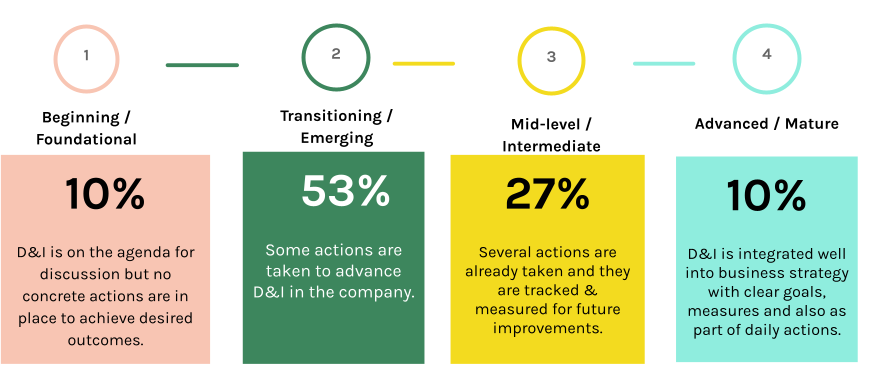
First, to understand the overall picture, let’s take a look at the different stages of D&I journeys in the companies. These stages, created by Inklusiiv, come in hand when we want to understand the development of diversity and inclusion work in different organizations.
Over half (53 %) of the companies that responded to the survey reported being at the “emerging” stage of their D&I journey. In other words, they have taken some preliminary steps to advance D&I in the company, such as a Code of Conduct. More than one in four (27 %) companies have already moved to the “intermediate” stage of the journey with more D&I actions and some measurement in place.
However, there is still a long way to go until businesses can get the full advantage of D&I – and that only results when D&I is seen as a strategic goal. Only one in ten companies are at the “advanced” stage of their D&I journey; meaning that they have integrated D&I well into business strategy with clear goals and daily activities.
Still, this data paints an optimistic picture of the future. There is a tremendous amount of steps – big and small – to be taken in organizations. The most encouraging finding is that 90 percent of the companies have already done some concrete actions to advance diversity and inclusion in their organization. This is a great start.
D&I in Finland – The Five Most Important Findings
1. Companies still favour more traditional D&I actions
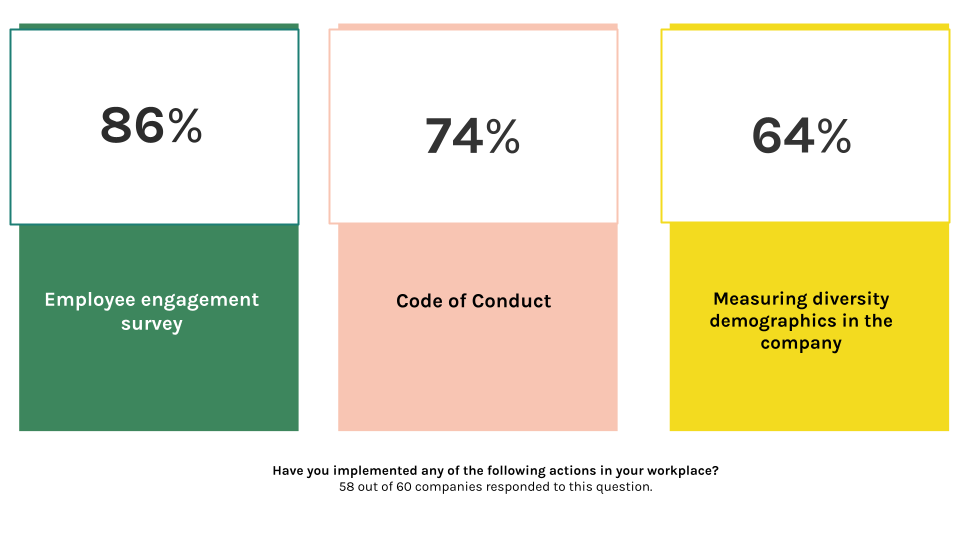
The survey revealed that Employment engagement surveys (86 %), Code of conducts (74 %) and measuring of diversity demographics in the company (64 %) are the most common D&I actions taken by the respondents.
These actions are all good starting points for any sized team or organization. Employment engagement surveys are rather easy to implement and they are truly a great tool to measure the degree to which employees feel valued in the organization.
2. Measuring and setting goals is not a routine
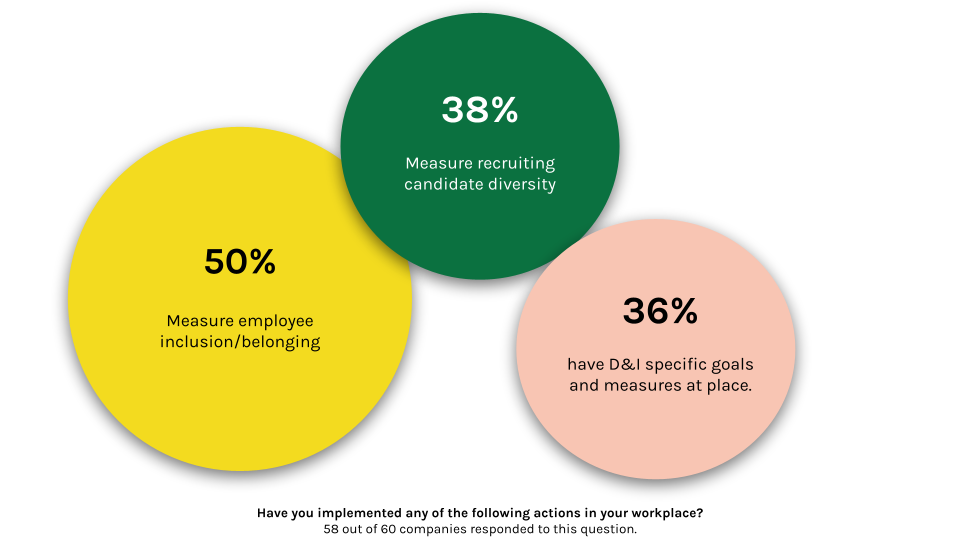
Half of the respondents measure employee inclusion and less than two out of five (38 %) measure recruiting candidate diversity. Only a bit over a third (36 %) of the companies are having D&I specific goals and measures.
Measuring and setting goals on D&I is crucial. Real data helps organizations to identify risk areas, prioritise the most important initiatives and measure the overall impact of their D&I actions. Here are some best practices examples from the survey respondents:
- Futurice highlights that they have done a D&I audit, incorporated D&I into the company strategy and set D&I ambitions, goals and roadmap. They have also got the Board’s commitment to hold themselves accountable for delivering on the goals.
- S Group has conducted a survey to ask employees’ views on inclusion and done a Konkari2020 -study to find out how age matters in the workplace and what older workers have to say. These studies have given S Group valuable insights into new projects and practices.
- Arla Oy has introduced “belonging” as a measurement in their Employee Engagement Survey. Arla has also raised inclusiveness as one of its top priorities in the 2021 Business Plan.3. Training, policies and plans are emerging
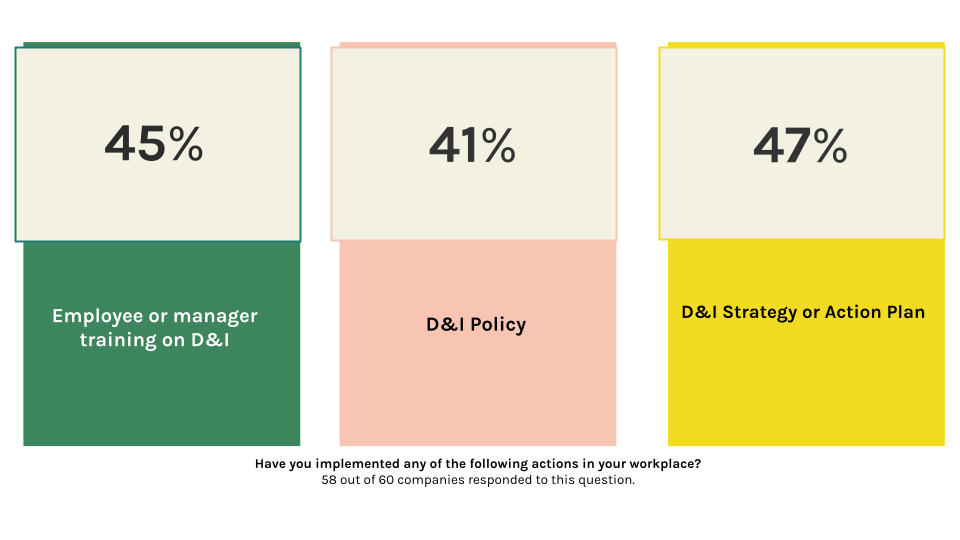
Trainings, policies and plans related to D&I help organizations to build more awareness and educate employees of the different aspects of D&I, and to iterate processes to build a more inclusive workplace. Here are some best practices examples from the survey respondents:
Almost half (45 %) of the respondents have conducted employee or manager training on D&I. 41% of companies have diversity and inclusion policies in action and almost half have done a D&I Strategy or Action plan.
- Danske Bank was one of the many respondents who had trained their management on unconscious bias. On top of that, they have also launched a training program to support inclusive management practices for all of their managers.
- Nokia closed the unexplained pay gap and is committed to closing it annually. They also have focused on the use of inclusive language in technology, training and customer documentation. Nokia is also working on a disability employment and management handbook for its People Managers.
- Aalto University has started work to eliminate binary gender categorizations in their systems and templates. They have also launched an online D&I learning hub. In addition to these, they have organized several staff trainings on D&I4. Hiring initiatives are not as common as you might think
Only one out of three (33 %) companies said that they have tried hiring initiatives (e.g. anonymous recruiting) around D&I.
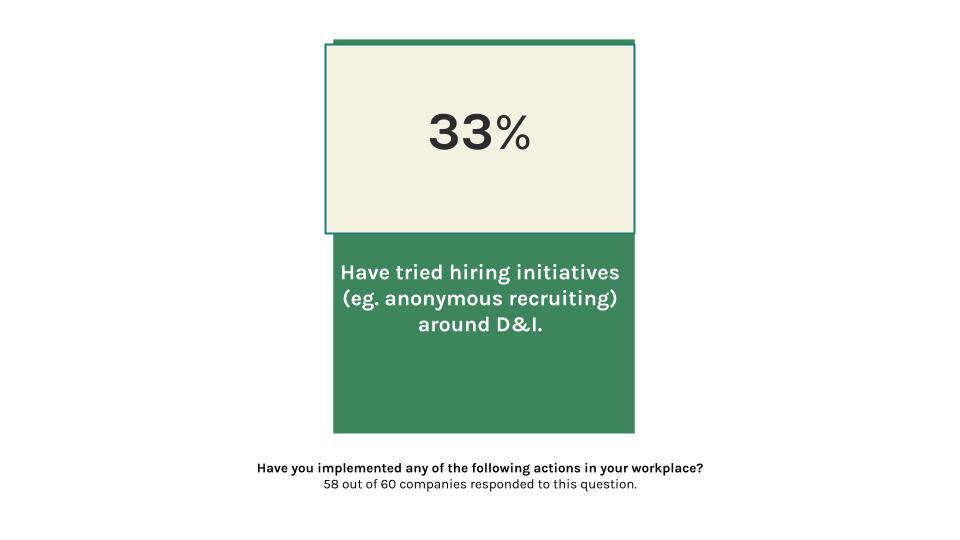
Inclusive hiring improves practices and processes in a way that it leads to hiring the best talent
Inclusive recruitment is a practice that ensures that the best professionals can be hired for organizations. There are many obstacles in our way to hire diverse talent and to make objective hiring decisions, such as unconscious biases. Building inclusive recruitment requires actions in all stages of recruitment from recruitment marketing to the actual interview practices. Here are some best practices examples from the survey respondents:
- Aalto University is driving this change through a gender decoder that promotes gender-neutral job ads. They have also briefed all committees in charge of promotions and hiring decisions of professors (Tenure Track committees) on D&I and implicit bias.
- S Group has tested anonymous recruiting, and as a result, ageless recruiting is now used in all recruitments.
5. There is untapped potential in Employee Resource Groups (ERG) and appointing a Head of D&I.
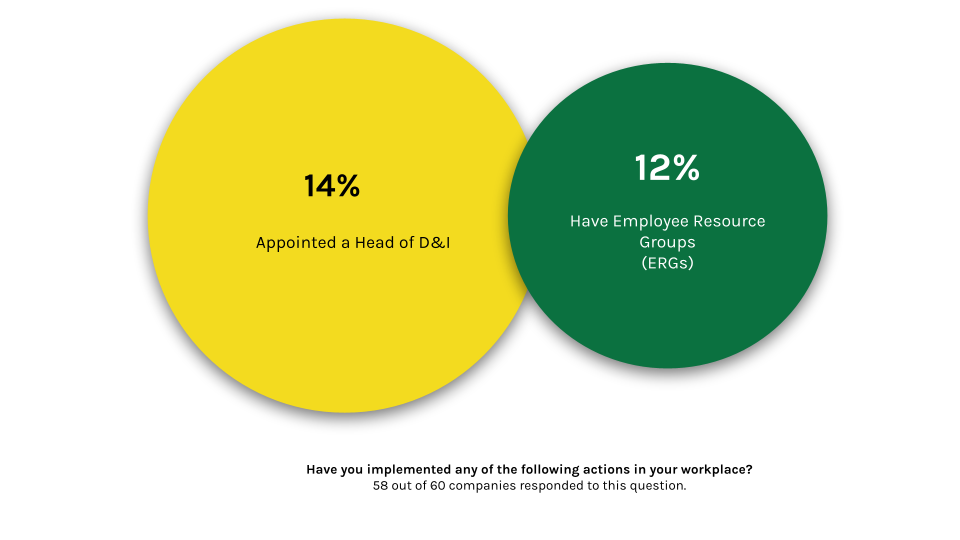
Only 14% of the respondents said that they have appointed someone as a Head of D&I.
Even fewer (12%) have Employee Resource Groups in their organization.
There is untapped potential in both. A Head of D&I, in the best-case scenario, can offer direction, give focus to the work and create lasting change through the collective effort in teams. However, it cannot be forgotten that the most influencing indicator for change to happen is the commitment of leadership and the CEO.
Employee Resource Groups (ERGs) are voluntary, employee-led groups that are formed to foster a diverse, inclusive workplace, which aligns with the organizational mission, values, goals, business practices, and objectives.
To sum up, these findings show that companies are starting to realize the value of the D&I as a strategic tool, and that they are also committed to take necessary action to advance diversity and inclusion in their organization. The change doesn’t happen itself and we’re here to help organizations on their journey.
Inklusiiv thanks every company which partook in our annual survey and offered valuable insights into the state of D&I in Finland.
Dive deeper into all of the survey findings of D&I in Finland from here.

You can also read our findings from the 2019 survey
https://www.inklusiiv.org/post/diversity-in-the-finnish-tech-industry

